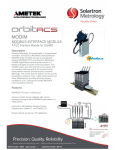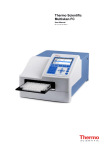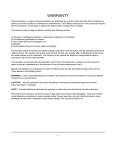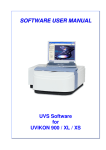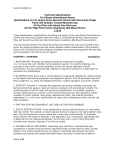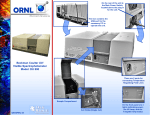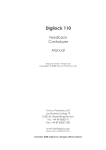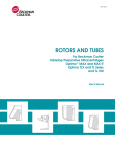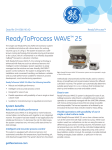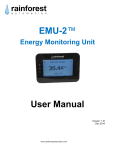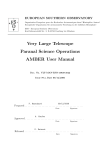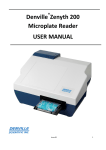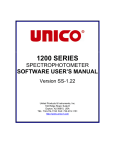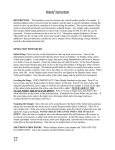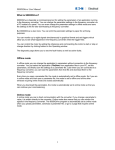Download Model 400 Series Spectrophotometer User`s Manual
Transcript
Photonics Model 400 Series Spectrophotometer User's Manual P/N 1656 Rev. D ©1994, 1995, 1996, 1997, 1998, 2000, 2005 S.I. Photonics, Inc. Tucson, Arizona Contents Table of Contents 1. Introduction to UV-Vis Spectroscopy..........................................................1 2. Installation and Setup....................................................................................2 2.1 Quick Installation Instructions.................................................5 2.2 Hardware....................................................................................7 2.3 Computer Requirements........................................................13 2.4 Lamp Adjustment....................................................................14 3. Software Overview......................................................................................20 3.1 Introduction.............................................................................20 3.2 System Overview....................................................................21 3.3 Drop Down Menus..................................................................28 3.4 Saving Files.............................................................................33 3.5 Exporting Data........................................................................37 4. Applications................................................................................................40 4.1 Peak Find.................................................................................40 4.2 Quantification..........................................................................47 4.3 Timed Acquisition...................................................................56 4.4 Kinetics....................................................................................62 5. Troubleshooting..........................................................................................63 6. Index.............................................................................................................68 Introduction Introduction The S.I. Photonics 400 Series Spectrophotometers are laboratory instruments that utilize the latest solid state CCD array detector technology. The optical system is specifically designed to be used with fiber optic probes for sampling. A variety of probes and probe configurations are available for different sample requirements. The instrument consists of tungsten and deuterium (model 420 and 440) light sources, optical shutters for the light sources, a spectrograph with integrated CCD array detector, and the detector control electronics. The tungsten source is part of the main power supply printed circuit board. The lamp is a miniature quartz-halogen type. The lamp output is optically regulated using a photodiode detector and feedback circuit. The lamp power supply also features over-current protection during lamp start-up and operation. The tungsten lamp is used for the 350 to 980 nm wavelength range when the deuterium lamp is not used and from 460 to 980 nm when the deuterium lamp is used. The deuterium lamp is a high output and long life unit capable of 4000 hours of operation. The lamp bulb is pre-aligned to a flange, which makes changing the lamp a simple operation. The lamp power supply and ignition functions are performed under software control so that the lamp is turned on only when needed for acquiring data in the 190 to 460 nm range. The spectrograph is a sealed, all-reflective optics system that uses a single mirror for collimating and focusing, and a 325-line/mm diffraction grating blazed at 300 nm. An integrated, fixed order-sorting filter is used to eliminate second order diffraction. The spectrograph optics, CCD array detector, and detector electronics are housed in an insulated, temperature regulated enclosure to ensure high baseline stability. A digital signal processor is used in the 400 series instrument to execute the commands issued by the host computer. This very high speed 24-bit processor directly generates the timing states necessary for CCD readout, sums the data from multiple CCD reads, and controls other devices in the spectrophotometer such as optical shutters and deuterium lamp power relays. The processor has an integrated serial communications interface that is used to transfer command, status, and data information between the spectrophotometer and the host computer. This User's Manual covers the installation, use, and maintenance of the S.I. Photonics 400 Series Spectrophotometers. It is valid for models 410, 430 (tungsten lamp source only) and 420, 440 (tungsten and deuterium lamp sources). 1 Introduction Items Included in 400 Series Systems Basic items shipped with your instrument are listed below, see the packing slip for a detailed list. 1) Spectrophotometer 2) Fiber optic sampling accessory 3) AC power cord 4) 6' long DB9M to DB9F RS-232 cable 5) Software installation CD including manual and tutorial 6) Trimpot adjustment tool 7) Hex wrenches (2) 8) Spare tungsten bulb Verify the contents of the shipping container and notify S.I. Photonics if any items are missing. We can be reached at (520) 293-6911 or via the internet at www.si-photonics.com 2 Introduction Technical Assistance, Service, and Spare Parts If it is necessary to contact S.I. Photonics for support, please have ready the instrument model number, serial number or optics serial number and control software revision number. The About Spectrometer window accessed from the Help menu contains much of this information. Print out a copy and keep on file for future reference. The model and serial numbers can be located on labels affixed to the inside of the instrument base. The software revision number is printed on the distribution CD label and can also be found in the View menu of the main front panel under VI info. Figure 1-1: About Spectrophotometer Window Replacement parts for the 400 Series Spectrophotometers are: Part Number 1991 Description Lamp, Tungsten, Quartz 1103 Lamp, Deuterium The tungsten lamp is part number Thorn M29 (product no. 72170T) distributed by Microlamp, Ft. Lauderdale, Florida and may also be purchased directly from them. It is recommended to have a spare tungsten lamp. For technical support and to order supplies and replacement parts contact the Service Department at (520) 293-6911 or via email at [email protected]. 3 Introduction Safety Message CAUTION! It is necessary to remove the cover of the 400 Series Spectrophotometer for some procedures described in this manual. In some cases, power to the instrument must be applied while adjustments are made. There are two regions of the instrument power supplies that are shielded and marked where dangerous voltages exist. Avoid touching any components behind these shields. If the shields are removed for any reason, re-install them before power is applied to the instrument. 4 Quick Installation and Setup Quick Installation Instructions This section is for those who either enjoy the challenge of setting up a new instrument without reading the manual, or do not have the patience to read a manual thoroughly before plunging in. If you are this type of person, and you have experience installing scientific instruments and Windows software, read this section to get up and running quickly. Then, when the excitement has worn off or you get stuck, go back and thoroughly read the manual. For those persons that are more cautious, read the manual Sections 2.2 through 2.4, then follow the instructions to get the instrument operational before continuing with the detailed software description. A tutorial video CD is also available that covers various topics including instrument setup and software features. Before you plug in AC power to the instrument, remove the cover by loosening (not removing) the four screws on the ends. If you are using 220VAC power, the power selection switch (located near the main power switch on the main power supply board) must be switched and the fuse value changed. If equipped with a probe, install the probe holder by sliding it onto the probe stand and install the fiber optic probe next. Make sure that the ends of the fiber connectors are clean (wipe with alcohol and lens paper), and that the SMA connectors are plugged into the correct locations. A nylon-tipped setscrew is used to hold the connector ferrules in the sleeves. Tighten the setscrews using the supplied hex (Allen) wrench. Replace the cover on the spectrometer and attach the AC power cord. Connect the RS-232 port on the spectrometer to an unused port on the host computer. An RS-232 to USB converter accessory is available for systems lacking an available serial port. When the Control Software CD is loaded Windows should automatically begin the installation process. If the install does not start automatically, execute the SETUP.EXE on the CD-ROM and follow the directions. Once installation is complete, start the SI400 application and turn on the spectrophotometer power. The tungsten lamp should immediately light, but the deuterium lamp (Model 440 and Model 420 instruments) will not light until commanded by software. Click the OK box to initialize the instrument. If the instrument is not communicating with the host computer, an error message will pop up. To correct the error, pull down the Operate menu from the main screen and click on the Configure option. Select the COM port that you are using on the computer. Leave the baud rate set to 38,400 as the spectrometer is shipped with this baud rate. Choose printer type, Monochrome or Color. Click the Save button to keep any changes, and then select from the Operate menu the Initialize item. 5 Quick Installation and Setup At this point, if everything has gone just right and the computer and spectrophotometer are communicating, you should hear a faint click-clack from the tungsten lamp shutter confirming communication. Also, the Blank button in the upper right corner of the screen will change from a light gray inactive mode to a red active mode. The Setup file is automatically read from the hard drive and the operating parameters of the spectrometer will be set. The parameters include the wavelength range and the lamp crossover wavelength. The wavelength scale on the main spectrum display will reflect the wavelength range. At this point, the wavelength range and lamp crossover wavelength can be changed if desired by selecting the Wavelength Range item, which is located in the Operate menu. If you have a Model 440 or Model 420 instrument and choose a wavelength that is below the lamp crossover wavelength, you will be asked to turn on the deuterium lamp. If you get error messages instead at this point, follow the advice of the error messages. Once the spectrophotometer is operating, immerse the probe in water, and start pushing buttons. The Blank takes a blank spectrum, and Sample takes a sample spectrum and records the results on the screen. Most of the buttons are self-explanatory in the usual Windows fashion. The Quantitative Item in the Operate menu, loads the quantitative analysis feature. The Timed Acquisition item in the Operate menu opens a new screen where entire spectra, discrete wavelengths and kinetics can be acquired at set time intervals. The Multi Spectra Display item can be accessed from the View Menu allowing up to 10 spectra to be viewed and manipulated. When you are ready for more detail, read Sections 3.1 through 4.4. This way you will be able to use the software to its fullest capabilities, and change lamps and adjust lamp intensity when the need arises. 6 Hardware Setup Setup of the 400 Series Spectrophotometer The 400 Series Spectrophotometer includes a fiber optic probe that is not connected during shipment. It is necessary to connect the probe in order to conduct the initial system tests. The probe stand and sliding probe holder is designed to conveniently hold the probe when it is not in use, or when sampling the contents of small containers. It is not essential for the operation of the spectrophotometer and may be removed if desired. Removing the Cover The spectrophotometer cover must be removed to install the probe. Before starting, make sure that the AC power cable is disconnected where it enters the instrument. Next, locate the four cover screws, two on each end of the instrument. Using a Phillips screwdriver, loosen the four screws approximately 5 turns, or 1/8". The screws should not be removed. Next, lift the cover straight up until it clears the internal components, and set it aside. BAUD rate table BAUD rate jumpers RS-232 connector Fuse holder AC power connector Power switch Spectrograph Voltage selection switch External lamp connector Cooling fan D2 power supply (only models 420/440) External shutter connector W lamp housing D2 lamp housing Input Figure 2-1: Main compartment of the 440 Series Spectrophotometer 7 Hardware Setup Inside the Spectrophotometer Inside the spectrophotometer is a compact spectrograph (which is thermally insulated for temperature stability), a digital electronic controller card, and the main and optional deuterium lamp power supplies as shown in Figure 2.1. Initial Inspection With the cover removed, inspect the inside of the spectrophotometer for any parts that may have vibrated loose during transit. AC Voltage Selection The spectrophotometer is configured to operate from 100 to 120VAC mains when delivered from the factory. If the instrument is to be operated from 220VAC mains, the AC voltage selection switch must be changed. This switch is located beneath a guard near the power switch. The switch is accessible through a hole in the guard. A small flat blade screwdriver is used to change the switch setting. Installation of Probe Holder To install the probe holder on the probe stand rod, squeeze the flat metal spring stop slightly and slide it first over the rod end with the black plastic surface on top. Installation of Fiber Optic Sampling Accessories All sampling accessories for the 400 Series Spectrophotometer are fiber optically coupled to the instrument. Each accessory will have either two (UV only or Visible only) or three (UV/Visible) fiber optic connectors. The standard probe supplied with the 400 Series instrument is a fiber optic dip probe. Also available with the instrument is the Universal Fiber Optic Sampling Bench, which can be fitted with a cuvette holder or optical filter holder, or a fiber optic reflectance probe. The 400 Series instruments are designed to be used with probes terminated with standard SMA type connectors, such as the standard fixed path length dip probes. The connectors are not attached to the instrument in the conventional manner of tightening the retaining nut, but rather the connector ferrule is clamped in place using a nylon-tipped setscrew. This approach was taken to ensure a more mechanically stable connection. It is important to use only the supplied nylon tipped setscrews to clamp the connector ferrules. Standard setscrews will damage the ferrule, and possibly break the fiber inside the connector. Fiber optic probes are fragile in some operations. Use caution with the probe as damaged probes cannot be easily repaired; replacement is usually the only alternative. The fiber optics in the probe are fragile and can be broken if 8 Hardware Setup mishandled by placing excessive tension stress, by exerting too small of a bend radius on the cable sheath, or by kinking or crushing the sheath. Never swing the probe from the fiber optic sheath, or pull on the probe when attached to the spectrophotometer such that the sheath is stretched tight. Fiber Optic Probe Installation The fiber optics at the connectors must be clean, free of dust and especially fingerprints (to avoid UV absorption) before they are installed. Use lens tissue moistened with isopropanol to clean if necessary. To install any of the sampling accessories, locate the small hex (Allen) wrenches provided with the instrument. Remove the plugs in the spectrometer where the fibers attach, and remove the caps from the ends of the fiber optic ferrules. Take care not to scratch or damage the ends of the fiber optics when the protective caps are removed. Insert the W source fiber into the W source bushing until it stops and secure it with the setscrew. Install the Input fiber (and for Model 420/440 instruments, the D2 source fiber) in the same manner. RS-232 Communications Link The communications channel between the host computer and the 400 Series Spectrophotometer is an RS-232 serial link. Information passed over this link includes commands to operate light shutters, initiate the CCD array detector readout, turn on or off the optional deuterium lamp, etc. The link is also used to pass the light intensity as a function of wavelength information used to determine the optical transmission or absorbance of a sample. One important task for the communications link is to initialize the spectrophotometer by passing a software program to its microprocessor. This task must be accomplished before the spectrophotometer can recognize any commands or perform any functions. Configuring the Communications Link In order for the communications link to pass information, it must be properly configured involving both the physical cabling of the host computer COM port to the spectrophotometer, and ensuring that the two pieces of equipment are communicating at the same data rate, or baud rate. All other communications parameters, such as number of data bits, parity bits, etc. are permanently configured in the spectrophotometer, and are configured in the host computer by the SI400 application without the need for user intervention. RS-232 Cable The communications cable must be a high-quality, shielded cable intended for RS-232 use, such as the one supplied with the instrument. This is especially critical when higher baud rates (19,200 and higher) are used. The cable supplied with the 400 series instruments is a 6' DB9 male to DB9 female, wired straight 9 Hardware Setup through (pin 1 to pin 1, pin 2 to pin 2, etc.) which can be connected to a DB9 male COM port connector on the host computer. A DB25 female to DB9 male adapter is also supplied to allow connection to a DB25 male serial port on the host computer. It is possible to use a longer cable; however it may be necessary to use a lower baud rate to ensure reliable communications. Connect one end of the cable to the spectrophotometer and the other to any unused COM port on the host computer configured as COM1, COM2, COM3, or COM4. If all COM ports on the computer are in use, it may be necessary to add a COM port connector or interface card. It is important that the COM port to be used is not sharing an interrupt. Refer to your computer equipment supplier for information. Baud Rate Selection It is advantageous to use as high a baud rate for the communications link that reliably works as spectral data will be transferred from the spectrophotometer and be displayed or analyzed faster. Under some conditions it may be necessary to decrease the baud rate to ensure reliable communications with some host computers. The COM ports for most modern PC compatible computers are capable of reliable operation at baud rates of at least 19,200 if the cable length is kept short. If it is necessary to use a cable of approximately 15' or greater between the host computer and the spectrophotometer, or if an older PC computer that can not support 19,200 baud is used, it will be necessary to decrease the baud rate to 9,600. If the host computer is capable of communicating at 38,400 baud or higher, and only the 6' cable supplied with the instrument is used, it may be advantageous to increase the baud rate. The baud rate for the 400 Series Spectrophotometers is set to 38,400 at the factory. With a 16550 UART serial port, baud rates up to 57,600 are possible To change the baud rate, it is necessary to remove the cover of the spectrophotometer (Refer to Section 2.2, Removing the Cover) and change the baud rate jumpers. The jumpers are on the controller board near the RS-232 connector. There are 3 pairs of pins emerging from a small block labeled JP1, JP2, and JP3. A plastic plug containing a wire fits down over a pair of pins electrically connecting them (Closed or 1) or is removed or pushed down over only one pin (Open or 0). Select the desired baud rate by positioning the jumpers as shown in the Table 1 below. This table is also printed on the controller board near the spectrograph. 10 Hardware Setup JP3 JP2 JP1 BAUD Rate 0 0 0 9600 0 0 1 19200 0 1 0 38400 0 1 1 57600 1 0 0 115200 1 0 1 230400 1 1 0 460800 1 1 1 921600 Table I: Baud Rate Jumper Table Figure 2-2: Configuration Drop Down Menu 11 Hardware Setup Spectrograph Warm-up At this point, the spectrophotometer cover is ready to be replaced. Follow the cover removal procedure in reverse order and then connect the AC power cord supplied to the instrument and to a standard 110VAC wall outlet. The spectrograph in the 400 series instruments is temperature regulated at approximately 35ºC to improve baseline stability. A warm-up time of approximately 30 minutes is required for the temperature of all optical elements to equilibrate. During this time, the baseline will drift. If careful measurements are to be made, or if long periods between blank and sample acquisition are anticipated, temperature equilibration and warm-up is essential. 12 PC Requirements Computer Requirements The host computer using the SI400 Series application software controls the 400 Series Spectrophotometer. This software system operates in the Windows 95 or later environment and conforms to normal Windows operating conventions whenever they apply. Users unfamiliar with the Windows environment should refer to the "Getting Started with Microsoft Windows" and "Microsoft Windows User's Guide" that is part of the Windows distribution package before proceeding. Host Computer Hardware and Software Requirements The SI400 control application runs under Windows 95, 98, NT, 2000 and XP operating systems. Minimum hardware requirements include: 1) a Pentium 90 CPU 2) a hard disk drive with a minimum of 6 MB free space 3) a CD-ROM Drive 4) a two-button mouse (or a three button mouse in two-button mode) 5) 32 MB RAM 6) one RS-232 serial port equipped with a 16550 buffered UART configured as COM1, COM2, COM3, or COM4 using the standard Windows addresses and interrupt vectors. The port can have either a DB9 or DB25 male connector. **Alternatively, an RS-232 to USB conversion cable is available for PC configurations utilizing USB input. A VGA monitor with a minimum 800 X 600 resolution is required. Throughout this manual, a basic knowledge of the Windows environment and its conventions is assumed. If necessary, refer to the Windows User's Manual for guidance. Installing the SI400 Control Software The SI400 Control Software is distributed in compressed form on a CD-ROM. The files must be installed onto your hard disk drive using and Setup program on the CD-ROM from Windows. Disks can be made from the CD-ROM – Call S.I. Photonics for instructions. To install, insert the CD-ROM into your drive. The install set-up window should open automatically, if not, go to the Start Menu and click on Run. Type in CD-ROM drive designation (i.e. D: ) A window will appear Click on SET UP. Press the Install button and follow the prompts to install. 13 Installation and Setup Lamp Adjustments The tungsten source used in the 400 Series instruments is a 10 watt quartzhalogen lamp with approximately 3100ºK filament temperature. Its average life expectancy is over 200 hours (longer life, lower output lamps are available; call S.I. Photonics for information). The deuterium source is a high-intensity, prealigned lamp with an average life of 4,000 hours. Both lamps need to be periodically replaced as normal instrument maintenance. The tungsten source is replaced only when it fails. The deuterium source is replaced whenever the estimated operating hours exceeds its lifetime, or when the lamp intensity and stability are unacceptable. Use care in replacing both tungsten and deuterium lamps as the lamp envelopes are fragile and can break during handling. Also, both lamps and their lamp housings become extremely hot during operation. Allow them to cool before disassembling. Finally, the deuterium lamp outputs ultraviolet radiation that is harmful to eyes and skin. Observe the precautions on the replacement lamp, and protect the eyes with plastic safety glasses designed to absorb UV light if it is necessary to view the lamp during operation. Adjusting Lamp Intensities Any time the tungsten or deuterium lamps are replaced or adjusted, or the fiber optic probe is changed on the spectrophotometer, it may be necessary to adjust the lamp intensities such that the minimum detector integration time is used, and the CCD detector does not become overexposed. This is accomplished by lamp intensity adjustment screws that prevent a portion of the light from the lamps from reaching the fiber optic probe input. During all lamp intensity tests and adjustments, the fiber optic probe used with the spectrophotometer should be installed and sampling a "blank". If a dip probe is used, it should be immersed in a blank solution. If a reflectance probe is being used, it should be pointed towards a white reflectance standard or shiny aluminized surface. The reflectance probe rarely needs the light reduced. To adjust the lamp intensity, the AC power must be disconnected and the spectrophotometer cover must be removed. Next, the main power must be reconnected while the cover is removed. Care must be taken to not touch any electrical components under or near the guards on the main power supply or the deuterium lamp power supply as high voltages exist in these regions. Also, avoid dropping tools or other metal objects that could cause electrical shorts in the spectrophotometer electronics. 14 Installation and Setup Switch on the spectrometer power and initialize. There is a lamp adjust utility that is accessed from the Configure option from Operate menu. Once the spectrometer is initialized, two additional buttons on the Configure screen become active for adjusting the deuterium and tungsten lamps. When pressed, a lamp adjustment window appears displaying a bar scale that monitors the intensity of the particular lamp. The bar is blue when the intensity is too low, green when it is in an acceptable range, and red when the intensity is too high. Locate the appropriate lamp intensity adjustment screw and adjust the lamp so that the bar is closest to the top of the bar scale while it is still green. At this point, the lamp intensity should be adjusted such that the detector is never over ranged, yet a minimum acquisition time is required. Deuterium lamp intensity The same Allen wrench used to lock the fiber optic probe ferrules in the spectrometer is used for the intensity adjustment screw. The Figure 2-3: Lamp Adjustment adjustment screw is self-locking, and is somewhat more difficult to turn than the probe setscrews. Turn the screw in or out to adjust the intensity. Lamp intensity adjustment screw Fiber optic clamp screw Figure 2-4: Deuterium lamp intensity adjust 15 Installation and Setup Tungsten lamp intensity The tungsten lamp intensity is adjusted by rotating a flag into the path of the lamp output. The exposure is very sensitive to the flag rotation. The hex head adjustment screw will rotate the flag; a correct size hex wrench was supplied with the instrument. The flag should have enough rotating resistance to stay in place. Intensity adjustment screw Adjustment flag tension screw (no adjustment necessary) Figure 2-5: Tungsten Lamp Adjustment Flag and Screw Tungsten Lamp Replacement Touching the replacement lamp envelope with the hands during installation can cause premature failure. Replacement lamps are shipped with a plastic or paper cover over the envelope to protect them from being touched. Do not remove this cover until the lamp is installed in the socket, and ready for installation in the lamp housing. If the lamp envelope is accidentally touched, clean it with absorbent lens tissue moistened with isopropyl alcohol. 16 Installation and Setup The AC power must be disconnected and the spectrometer cover must be removed. The tungsten lamp housing on the main power supply circuit board, is located to the left of the main power supply transformer. The tungsten lamp is retained in the housing with a spring-loaded clamp. Grasp the clamp at the hook in the clamp stem between the two springs and lift straight up to release. Lamp socket (shown partially removed) Clamp (shown lifted) Lamp Housing Fiber optic locking setscrew Lamp current indicator Lamp current adjustment trimpot Shutter/photodiode mount Figure 2-6: Tungsten Lamp Housing Location Grasp the lamp socket leads and pull the lamp socket from the housing. Pull the lamp from the socket and discard. Install the replacement lamp in the socket, remove the protective cover, and then set the lamp into place in the housing while again pulling up on the clamp. Before releasing the clamp, make sure that the lamp is properly seated in the housing such that the bulb is not damaged. Gently release the clamp to secure 17 Installation and Setup Adjusting Tungsten Lamp Current In the event that the tungsten lamp may need adjustment or is removed and reinstalled for any reason, the lamp current set point must be adjusted. This is performed by adjusting a trimpot until a LED indicates the proper lamp current. The lamp current is adjusted with the spectrometer cover removed, and power applied. Make sure that the tungsten lamp is illuminated and the deuterium lamp is off before proceeding. Locate the lamp current adjustment trimpot and the lamp current indicator LED. Use a trimpot adjustment tool to turn the trimpot clockwise until the LED is illuminated. Next, turn the trimpot counterclockwise until the LED just becomes fully extinguished. When the lamp current indicator is not illuminated, the lamp current is being regulated at the correct level by an optical feedback circuit. This trimpot is NOT meant for adjusting the lamp intensity. Before placing the unit in service, if necessary adjust the lamp intensity. Deuterium Lamp Replacement The AC power must be disconnected and the spectrometer cover must be removed. Locate the deuterium lamp electrical connector near the right side of the lamp power supply transformer. There is a latch on the right side. Press the top of the latch towards the connector body to release it, then pull straight up on the connector to detach it from the printed circuit board. The deuterium lamp is held in its housing by two screws located on top of the lamp mount. Use a small, flat blade screwdriver to remove these two screws. The lamp can now be lifted from the spectrometer and disposed. Install a new lamp by reversing the procedure above. No optical alignment is necessary. If necessary before placing the unit in service, adjust the lamp intensity. 18 Installation and Setup Deuterium lamp electrical connector Connector Latch Lamp mount screws Deuterium lamp electrical socket Lamp intensity adjustment screw Fiber optic clamp screw Figure 2-7: Deuterium Lamp Housing and Electrical Connector Lamp Warm Up Times Both tungsten and deuterium lamps require a warm up period of approximately 1 hour before they reach maximum stability, but for routine use, 30 minutes may be sufficient. The lamp warm up time is independent of the time necessary for the spectrograph temperature to stabilize. This is especially important to remember if the deuterium lamp is not turned on when the instrument is first powered up. If either lamp has not had sufficient warm up time, baseline drift will be observed. 19 Software Overview Software Overview Introduction The SI400 Control Software uses the Virtual Instrument (VI) concept where the various buttons, knobs, dials, displays, and controls that you would expect to find on an instrument, along with pull down menus, have been replaced by their graphical equivalents that appear on the computer screen. The instrument hardware no longer has physical controls, but the combination of computer screen, keyboard, and mouse has replaced their function in ways that can be easily optimized for specific tasks. The SI400 applications have different front panels for general data acquisition, quantitative data acquisition, and for acquiring data at fixed time intervals, each optimized for the specific task. During installation a program group was created and can be accessed in Windows 95/98/NT/2000 and XP from the Programs item on the Start menu. To start the application, SI 400 program group icon, then double click on the SI400 application icon. If you do not select to have a program group created, execute the SI400.exe program using the file manager. When the SI400 application is started, it presents the main VI front panel that appears (see Figure 3-1 Main front panel) to have an assortment of buttons and other digital controls and drop down menus, along with a graphical display of optical absorbance, transmission or reflectance. The buttons are "pressed" by using the mouse to point to the button, and pressing the left mouse button. If a button is active, it will react when pressed so that it looks like it was pressed, and that some activity is being performed. There are times when a button cannot become active until some other function is first performed. For example, the Blank button is inactive until the instrument is initialized. The Sample button is inactive until a blank has been acquired. When a button is inactive, it is a light gray, semitransparent color. 20 Software Overview System Overview: Main Panel In this section the various features of the 400 Series Control Software are demonstrated. The figure below shows a graphical representation of the front panel with each feature identified. At this point it is advisable to acquire both a blank and a sample spectrum so that you can evaluate each feature as they are presented. Drop Down Menus Cursor Position Indicators Cursor Step Scrolling Graphical Display Preferences Cursor difference Indicator Measurement Unit Sample Acquire Blank Acquire Graphical Display Zoom Restore Y Axis Auto Scale Reference Spectrum Display Save File Name Peak Smoothing Comment Entry Fields Initiate Peak Find Deuterium Status Current Date Current Time Last Baseline Acquired Discrete Wavelength Information Table Figure 3-1: SI400 Control Software Main Panel 21 Update Cursor Information to Table Software Overview Measurement Unit Allows the user to toggle between measurement modes including Absorbance, Transmittance, Reflection and Intensity. Since the raw data is stored in memory, the units can be mathematically adjusted after the acquisition. Sample Once a blank has been acquired the sample button becomes active and sample measurements can be acquired. A full spectrum acquisition is automatically presented in seconds. Blank Allows for the establishment of a baseline for subsequent sample measurements. Lock Blank Locks the blank button so that the current baseline cannot be accidentally overwritten. Restore Full View Restores current graphical display to the original aspect ratio as demonstrated when the sample was acquired. This feature is used to return to normal view if a zoom feature or different scaling was used. Y Scale Restore Restores display to the original Y-scale displayed when the sample was acquired. This feature is useful if a zoom or different scaling were used. Reference Spectrum Allows for two spectra to be viewed and one is designated as a reference. Deviations between samples can be ascertained using this feature. Peak Smoothing Smoothes displayed data using a Savitzky-Golay quadratic-cubic algorithm with an adjustable number of points. This effectively increases the signal to noise ratio of spectral data at the expense of reduced spectral resolution. Data saved to disk files is not saved in smoothed form, but any file read from disk can be smoothed. The smoothing algorithm is described in J. Anal. Chem., 1964, 36, p. 1627. UV Lamp Turns on or off the deuterium lamp. The lamp power supply requires approximately 20 seconds to ignite the lamp discharge. The lamp should be allowed to warm up for at least 20 minutes to reach maximum stability. Baseline drift will be observed if the lamp has not had time to stabilize. 22 Software Overview Peak Find Opens a new front panel for automated peak and valley analysis. Push the Close button to return to the main front panel. Function Key F4 Blue Cursor Adds an entry into the wavelength column of the Data Table at the current position of the blue cursor. Red Cursor Adds an entry into the wavelength column of the Data Table at the current position of the red cursor. Update Table Updates the absorbance, % transmission, % reflectance or intensity fields in the Data Table. Used when wavelengths are manually entered in the Data Table rather than using the blue cursor/red cursor buttons. Clear Table Clears the Data Table. λ Table The wavelength table is useful when referencing specific or multiple wavelengths for analysis. Users can manually type the desired wavelength into the table and depress the Update Table button to retrieve the information. Alternatively, users can drag the blue and red cursors to the desired location and depress the Blue Cursor and Red Cursor buttons to update the table with those specific coordinates. 23 Software Overview File Name Indicates the file name to which the current spectrum will be saved. Comment This field allows users to enter specific information and experimental conditions about a sample. Operator Allows for the entry of a user name indicating the name of the analyst. Blank Indicates the date and time when the last blank spectrum was acquired. Info Table Allows users to enter specific information about a spectrum. Date & Time Displays the date and time the current spectrum was acquired. 24 Software Overview Graphical Display Displays the current spectrum on the monitor. X-axis consists of wavelengths while the Y-axis indicates the measurement mode. Users can select either a blue or red cursor for assistance in identifying specific spectral features. Zooming can be accomplished by directly editing the max/min labels on the axes’ of the graph. Clicking on the max or min label on either axis and editing it to the desired value does this. The tic marks will automatically be adjusted. A right mouse click allows for changing of display views. Cursor Indictor The cursor position indicator is located just above the graphical display and identifies the wavelength and intensity. Users can choose either blue or red cursor mapping. The small square indicator changes from white to black indicating which cursor is currently enabled. An icon consisting of the cursor intersection within a small white box is a control that allows changing various cursor display attributes such as a cursor or no cursor. Clicking on this will bring up a menu of selections. An icon that appears as a padlock to the right of the attribute control is a control that forces the cursor to be constrained to the displayed data points, or free to move anywhere on the display. The four-diamond triangle located immediately to the right of the cursor position indicator allows for single step incremental scrolling of the cursor currently selected as indicated (↑) by the darkened box. Depressing the right mouse button allows users to hide the cursor indicator. 25 Software Overview Graphic Control Axis Lock The graphic Control allows for modifying the appearance of the displayed spectrum. The X and Y buttons on the left side of the Graphic Control permit locking of either axis. When selected, the X an Y axis will no longer autoscale with successive spectrum acquisitions but instead will remain fixed at the established values. If autoscaling is turned on, the display scale will be adjusted to the data whenever the display is updated (such as when a new spectrum is acquired). When autoscaling is turned off, the display scale will remain constant during data acquisitions. Display Units X.XX and Y.YY buttons allow users to select the desired display units, significant figures, etc. Zoom The zoom button allows users to select the between a variety of zoom options. Zoom Region User selects a defined zoom region Zoom Wavelength Region User defines the wavelength region to be zoomed Zoom Y-Axis Region User selects the defined y-axis region to be zoomed Zoom Restore Returns graphical display to it original size Zoom In Stepwise Permits stepwise zooming in of a selected region Zoom Out Stepwise Permits stepwise zoom out of selected region 26 Software Overview Panning Allows users to pan around the Graphical Display Cursor Select Allows users to select either the blue or the red cursor Delta X Displays the wavelength difference between the two cursors. Delta Y Displays the intensity unit difference between the two cursors. 27 Software Overview Drop Down Menus This section summarizes the features for functions accessible from the drop down menus. File Menu Open Loads a previously saved spectrum and dataset. Function Key F6 or Ctrl+O Save Saves the current spectrum and dataset. Function Key F7 or Ctrl+S Save As Saves the current spectrum and data set as either a text or an Excel file format. Auto Save Automatically saves each successive spectrum and dataset to a selected file in the *.SIS format. Auto Save As Automatically saves each successive spectrum and dataset as either the default *.SIS format or as a *.TXT format. Export Exports a single file or group of files that have been saved on the disk to an Excel or delimited ASCII text spreadsheet file. Select the Export function from the Files menu and a window will open (Figure 3-6 Directory Selection) asking the user to select the directory or folder containing data files to be exported. Function Key Ctrl+E Set File Filter Limits the sort criteria when retrieving files. Save Setup Saves the current settings of the program to be recalled when the spectrometer is initialized. The settings saved include the wavelength range, lamp crossover wavelength, the table of wavelengths to be monitored, current disk paths for data, precision setting, smoothing on/off and points, and the grid on/off. Print Graph & Info Outputs the displayed spectrum, comments section and dataset to the selected Windows output device. Function Key Ctrl+P Print Only Outputs the displayed spectrum to the selected Windows output device. Graph Printer Setup Recalls the Windows printer setup dialog routine. Exit Closes the application. 28 Software Overview Edit Menu Cut Cuts the selected information and copies it to the clipboard. Copy Copies the selected information to the clipboard. Paste Pastes the clipboard contents into application. Clear Deletes the current entry. Preferences Allows for customization of input/output path selection, PC memory allocation performance, display options and colors, printing margins, time and date formats. 29 Software Overview Operate Set Precision Allows users to select the desired level of precision and acquisition speed. Available options are low, medium and high precision. Wavelength Range Allows users to select the desired wavelength range and source lamp crossover wavelength. Key Function Ctrl + W Quantitative Opens the quantitative analysis feature. Function Key Ctrl + Q Timed Acquisition Opens the timed Acquisition and kinetics features. Function Key Ctrl+T Initialize Established communication with spectrophotometer by utilizing information input through the Configure option. This dialog is automatically executed during instrument power on after the SI 400 Software Application has been selected. 30 Software Overview View Multiple Spectra Opens the Multiple Spectrum Display feature allowing for the view of up to 10 spectra at once. from the View menu opens a new front panel to view up to 10 spectrum at once. Auto Add to Multiple Spectra automatically places the newly acquired spectra into the Multiple Spectrum Display feature. Function Key Ctrl+M Restore Full View Displays original spectrum to full scale. Function Key F3 or Ctrl + F Grid Allows user to add or remove the grid lines in the spectrum. Function Key Ctrl+G 31 Software Overview Help Show Help Provides a description of each feature currently selected by moving the cursor over the selected item. An on-line help feature is available to explain the purpose and functions of the various controls and indicators on all front panels except the previously described controls associated with the graphical displays. A help window is opened by selecting "show help" item from the Help item on the menu bar or with the key combination Ctrl + H. The help window will contain a description of the control or indicator that the mouse cursor is currently over. To view a description of a control or indicator, simply position the mouse cursor over the item of interest. About Spectrometer Provides system information including software version, spectrograph calibration coefficients and controller hardware. 32 Saving Files Saving Files Save The most common way to save a current data file is to use the Save or Save As options from the File menu. Selecting the Save option will result in a typical Windows dialog box allowing users to select a specific file location for saving files. Figure 3-2 : Saving Data Files Current data files acquired using the Main Panel or Quantitative feature will be saved with the default *.SIS file extension. This ensures data security as these files can only be accessed via the 400 Series software and cannot be altered. The displayed spectra, comments and data table contained on the screen will be saved to the designated folder. Data files can be retrieved using the Open menu option. The hotkey option for saving data files is accessed using Function Key F7 or Ctrl+S. Data files acquired using the timed acquisition feature will be saved as a *.SID file format which cannot be altered as well. In addition, files having the *.SID file extension can only be accessed via the timed acquisition menu. 33 Saving Files Save As Selecting the Save As option permits users to choose between text or Excel file formats for saving data files. Selecting either the Text or the Excel format will result in a different Windows dialog box allowing users to select either the *.TXT or *.XLS file extension formats. These files cannot be opened in the SI400 application. Figure 3-3: Saving Files in Text or Excel Data files that have been saved using either the *TXT or *.XLS file formats can be readily imported into various spreadsheet programs such as Excel and Quattro Pro as well as text recognition programs. The *.TXT file extension is a comma delimited format. It should be noted that data files containing the *.TXT or *.XLS are editable and therefore the data content is not secure from manipulation or tampering. 34 Saving Files Auto Save The Autosave feature allows users to automatically save each successive spectrum and dataset to a selected file in the *.SIS format. Selecting the Autosave option will result in a new dialog box prompting the user to input a file name and select the appropriate folder for successive files to be saved to. Figure 3-4: Auto Save Path Settings Depressing the Select Folder button will result in another dialog box allowing the user to select the appropriate folder and location. Once the appropriate folder has been selected the user can chose the Select Current Directory button and all subsequent data files will be saved to the appropriate file location. Figure 3-5: Selecting File Folder 35 Saving Files Auto Save As The Auto Save As option allows users to automatically save a data file as the default *.SIS format or can be selected to save as *.TXT file extension. 36 Exporting Data Exporting Data Export Selecting the Export option from the File menu exports a single file or a group of files that have been saved on the disk to an Excel or delimited ASCII text spreadsheet file. A new pop-up window will open prompting the user to select individual data files or a folder containing a group of files to be exported. In the active window choose individual files using the Shift key and right clicking the mouse button for individual files. To select an entire file for exporting, choose the Select New Folder button to designate the folder containing the data to be exported. Figure 3-6 : The file list contains the files for export 37 Exporting Data If the Select New Folder option was chosen, a new dialog window will appear prompting the user to select the desired folder. Once the desired folder has been highlighted, the Select Cur Dir button located at the lower right of the dialog window should be selected. This will return the user to the previous screen indicated in Figure 3-6. The selected files will be indicated in the File List dialog box. Figure 3-7: Selecting File Folder Once the appropriate data files are indicated in the File List dialog box, a new window opens and listing the selected files and allows the user to choose the type of data to export, the type of file format, and whether to smooth the data. Figure 3-8: Selecting File Format 38 Exporting Data The final window in the export dialog prompts the user to select the appropriate file format and destination. The exported data must have the same wavelength range since the first column contains the wavelength values and each successive column contains data for each selected file. Figure 3-9: Choosing Files to Save At this point the user can complete the export process by pressing the Save button, or Cancel the operation. 39 Applications Peak Find The Peak Find feature is opened by pressing the button on the Main front panel. This feature is used to analyze the peaks and valleys of a spectrum and display the associated wavelengths and intensities. These values are also displayed in the Wavelength Table. A spectrum must have been taken or opened in the Main front panel before utilizing the Peak Find feature. Figure 4-1: Peak Find front panel The graphical display on the Peak Find front panel is used to present absorbance, transmission, reflectance or intensity as a function of wavelength. When the window is opened, the default representation will show the peaks of the spectrum. To view the valleys of the spectrum, select the box in the lower right corner, and choose the valley option. 40 Applications Peak Find Front Panel Controls Close Closes the Peak Find front panel and opens the Main front panel Film Thickness Calculates the thickness of substrate in micrometers (um). The user must type in the refractive index of film being tested. This calculation is found under the peaks find table in the “No Calculation” menu. Find Peaks Calculates the highest point in each peak, or lowest point in a valley, marks the spectrum and updates table up to 60 points. (Function Key F5) Peak Width Used in the calculation determining the peaks. Peaks/Valleys Toggle switch to change the display of peaks to valleys. Smoothing Smoothes the data that is displayed by a Savitzky-Golay quadratic-cubic algorithm with an adjustable number of points. This effectively increases the signal to noise ratio of spectral data at the expense of reduced spectral resolution. Data saved to disk files is not saved in smoothed form, but any file read from disk can be smoothed. The smoothing algorithm is described in J. Anal. Chem., 1964, 36, p. 1627. Points Varies the number of points in the smoothing algorithm. As the number of points is changed, the current spectrum displayed is dynamically updated with the new smoothing parameters. 41 of Applications On/Off Turns smoothing on or off. Only the currently displayed spectrum is affected. Once smoothing has been turned on any subsequently acquired spectra, or data files read from disk will be automatically smoothed. Threshold The threshold cursor allows the manipulation of the peak find function to only show the peaks above the threshold cursor level. In valley analysis, only the troughs below the threshold cursor are displayed. The cursor movement is performed the same as the other two cursors. The default color for the threshold cursor is purple and is represented as a horizontal line in the graphical display. Y Scale Adjusts the y-axis to fit the spectrum to fill the full display. Cursor Status Indicator Displays the current cursor position with respect to wavelength and intensity. The cursors are color coded for clarity. 42 Threshold Multiple Spectra Display Multiple Spectra Overlay The Multiple Spectra Display is accessed through the View menu on the Main front panel and is used to see and manipulate up to 10 spectra at a time. To be displayed in this window, the spectra must have been acquired in the Main front panel or as saved disk files. Figure 4-2: Multi Spectra Display front panel The spectra can be manually opened in the Multi Spectra Display window from saved files or they can be automatically transferred over by selecting the Auto Add to Multiple Spectra option in the Main front panel. This feature is on by default. As each spectrum is acquired and transferred to the Multi Spectra Display panel, the spectrum shift down the list. When more than 9 spectrum are opened or transferred, the spectrum are removed from the bottom. The tenth spectrum in the table is a reference cell and will not automatically be removed. The spectrum in the Multi Spectra Display front panel can be manipulated in simple mathematic functions such as adding, subtracting and multiplying. The arithmetic can be performed on the spectra with two spectra or a spectrum and a constant. The newly formed spectrum will transfer up to the number one spectrum cell in the table. 43 Multiple Spectra Display Graphical Display The graphical display on the Multi Spectra Display front panel is used to present absorbance, transmission, reflectance or sample or blank intensity as a function of wavelength. The spectra displayed can be turned on and off by selecting the on/off button next to each spectrum. Controls The following is an alphabetical listing of Multi Spectra Display controls Blue Cursor - Adds an entry into the wavelength column of the data table at the current position of the blue cursor. Calculate – Performs the mathematical operation between the two selected spectra or spectra and a constant value. Clear Spectrum – Clears all or individual spectra from the spectra list. Clear Table - Clears the data table. Close – Closes the Multi Spectra Display panel and re-opens the Main front panel. Export Files - From the File menu exports a single file or a group of files that have been saved on the disk to an Excel spreadsheet file or a delimited ASCII text spreadsheet. File Name Filter - limits the sort criteria when retrieving files from the disk. Grid – From the View menu allows user to add or remove the grid lines in the spectra display. Info – Opens a new window to edit and review File Name and Comment section ON/OFF – Adds or removes the spectra from the display window 44 Multiple Spectra Display Figure 4-3: Spectra Info Box Open File - Opens a data file created with the Save File menu item. The spectrum in the data file, along with all other file information, is displayed. Open Multiple Files -Opens multiple data files saved on disk. The spectrum in the data file, along with all other file information, is displayed. Select a Folder – Opens new window to selects a folder from which to open files. Click on Select Cur Dir to finish operation and return to Open Multiple Files window. Select Files – Click on individual files or use the shift key for multiple selections up to 9 spectra. To select a contiguous series of file names, shift + click and drag. Click OK to finish. Print Graph - Outputs spectrum only with legend Restore Full View – Rescales the image to the original settings. Save – Select the spectrum to be saved and edit comment section in the comment window. Click on Close and a save file window opens. Type in file name and click on Save. Set Reference – Selects which spectra in the table is to be used as a reference and transfers all data of the chosen spectra to the reference spectrum destination. To transfer a spectrum into the reference cell, the spectrum must be turned ON to come up in selection choices. 45 Multiple Spectra Display Smoothing - Smoothes the data that is displayed and that used for quantitative data analysis by a Savitzky-Golay quadratic-cubic algorithm with an adjustable number of points. This effectively increases the signal to noise ratio of spectral data at the expense of reduced spectral resolution. Data saved to disk files is not saved in smoothed form, but any file read from disk can be smoothed. The smoothing algorithm is described in J. Anal. Chem., 1964, 36, p. 1627. On/Off - Turns smoothing on or off. Only the currently displayed spectrum is affected. Once smoothing has been turned on any subsequently acquired spectra, or data files read from disk will be automatically smoothed. Points - Varies the number of points in the smoothing algorithm. As the number of points is changed, the current spectrum displayed is dynamically updated with the new smoothing parameters. Update Table - Updates the absorbance, % transmission, % reflectance or intensity fields in the data table. Used when wavelengths are manually entered in the data table rather than using the blue cursor/red cursor buttons. View All – From the view menu, turns all spectra in the table to the ON position, displaying all spectra. Y Scale – Adjusts the y-axis to fit the spectrum to fill the full display 46 Quantitative Analysis Quantitative Analysis Quantitative Analysis Front Panel The Quantitative Analysis feature is accessed via the Operate menu on the Main Panel. Before opening the Quantitative Analysis front panel, it is best to take a blank spectrum and a sample spectrum of a standard solution to facilitate the choosing of analysis wavelengths. Controls are available to acquire data from standards and unknowns, fit standards data to a calibration curve, and determine concentrations of unknowns based on the calibration curve data. The Quantitative Analysis front panel has a graphical display for analytical data and a calibration curve, a section for controls and data related to analytical standards and a section for controls and data related to unknowns. Figure 4-4: Quantitative Front Panel 47 Quantitative Analysis Standards and Unknowns Tables The standard number and concentrations for each standard are entered in the Standards Table. The absorbance for the standards at the analytical wavelengths and the confirmation wavelengths will automatically be entered into the rest of the table when the Acquire Standard button is pressed. Description for the unknowns is entered in the Unknowns table. Concentration and absorbance results will be calculated and inserted when the Acquire Unknown button is pressed. Graphical Display The Graphical Display on the Quantitative Analysis front panel is used to present absorbance as a function of concentration information. Data from the analytical wavelength, or confirmation wavelengths, can be viewed directly from the graphical display as well as the tables. The Graphical Display contains many of the control features as indicated on the Main Panel for your convenience in viewing your data. Comment and File Name Dialog Boxes The upper right corner of the Quantitative Analysis front panel contains many of the same user dialog entries as indicated on the Main Panel. These entries allow the user to specify comments, user name and file name. 48 Quantitative Analysis Quantitative Analysis Procedures Once the Quantitative window is open, the procedure for performing quantitative analyses is as follows: Select the Operate menu option and choose Selected Wavelengths. The Quantitative Wavelengths Selection menu will allow for the selection of the wavelengths to be used for analysis. Figure 4-5: Quantitative Wavelengths Selection Menu The Analytical Wavelength is usually the wavelength of maximum absorbance for the sample. The Reference Wavelength is usually a point of minimum absorbance for the sample. When a Reference Wavelength is selected true background correction is available. The absorbance at this wavelength is automatically subtracted from the absorbance at the Analytical Wavelength during the computations in the Quantitative Analysis front panel. This is a substantial feature not available on scanning instruments. The Confirmation wavelengths are typically used for tests of purity or chemical interference in a sample. The wavelength is usually chosen in a region of appreciable absorbance, but removed from the Analytical Wavelength. The selection of analytical, reference, and confirmation wavelengths may be made by typing in the value into the appropriate box. An alternate method is to position a cursor at the desired location on the spectrum in the graphical display. Select Analytical, Reference, Confirmation 1, or Confirmation 2 on the Wavelength Selection control box and press the Blue Cursor or Red Cursor 49 Quantitative Analysis button depending on which cursor is being used. The wavelength of the cursor is entered into the selected item. A spectrum of an analytical standard must be acquired in the Main front panel to use the graphical input approach. Each type of wavelength must be turned On in order to be incorporated into the quantitative calculations. 1. There is an option to acquire a new blank spectrum if it is deemed necessary. Press the Unlock Blank button to make the Blank button active and proceed with taking a new blank. After the blank is acquired, the Blank button is automatically locked to lessen the chance of it inadvertently being pressed. 2. Enter the concentrations of the standards into the Standards Table. If there are more than ten standards, a scroll bar will appear on the right side of the table to allow the table to be scrolled down. 3. Next, acquire the spectra for the standards. When the Acquire button for standards is pressed, the data will be put into the table for the standard number indicated in the Standard Number control. This control defaults to 1 and will automatically increment to the next standard number. This control can also be used to manually set the next standard number to be acquired. 4. When all the standards have been acquired, select the Calibrate item in the Operate menu and the calibration curve (linear least squares fit) for the data will be calculated and displayed on the Graphical Display. At this point, the fit results can be viewed by pressing the View Fit Results option in the Operate menu. 5. Now you are ready to measure the concentration of unknown samples. Prepare the first unknown sample to be measured. A description can be typed into the unknown table in the Name column. The Unknown Number control selects the unknown number in the Unknowns Table for which data will be collected. This control is initially set to 1 and will automatically set to increment to the next number after a new spectrum is acquired. Data is acquired by pressing the unknown Acquire button and the results will appear in the Unknowns Table. There are scrollbars on this table for both vertical and horizontal movement. The horizontal scrollbar allows viewing of the results for the Confirmation Wavelengths. 50 Quantitative Analysis Quantitative Front Panel Controls Acquire Two Acquire buttons are present, one in the standards section and the other in the unknowns section. These buttons acquire a spectrum for the data tables they are adjacent to. The standard and unknown numbers are chosen before the acquisition, then data is stored in the corresponding line in the table. For the standards Acquire button, the known concentration must be entered before taking the spectrum. NOTE: Analytical, reference and confirmation wavelengths must be set before the button is active. See Wavelength Selection. Function Key Acquire Standards F1 Function Key Acquire Unknowns F6 Blank Acquires and stores spectrum of blank sample for calculation of absorbance and % transmission relative to sample spectrum. Data is stored until the wavelength range is changed or a new blank is acquired. Select Wavelengths Calibrate Located in the Operate menu, this option opens a new front panel that displays a graph of a spectrum for the selection of analytical, reference and confirmation wavelengths for the quantitative analysis front panel. Found in the Operate menu calculates the best fit function to standards data using linear regression. 51 Quantitative Analysis View Fit Results Displays statistical data from linear regression for Analytical and Confirmation wavelengths and is found in the Operate menu. Clear Standards Clears all information entered into the Standards Table and accessed from the Operate menu. Clear Unknowns Clears all information entered into the Unknowns Table and accessed from the Operate menu. Close Closes the Quantitative front panel and opens the Main front panel. Data in the Quantitative front panel will not be lost. Concentration units Molarity Data units displayed as molarity (mol/L). PPM Data units displayed as parts per million (ppm or mg/L). Format Sets the display preferences for concentration values. The units may be decimal, scientific or engineering. Number of decimal places displayed is also set here. Function Key F11 Spectrum Found under the View menu displays a spectrum at full screen size of the most recent spectra acquired. Standard number Changes the line number where data is inserted in the Standards Table when Acquire button is pressed. This number will automatically increment by one after each sample. 52 Quantitative Analysis Unknown number Changes the line number where data is inserted in the Unknowns Table when Acquire button is pressed. This number will automatically increment by one after each sample. Unk. Conf. Used to set the acceptable percent difference between analytical and confirmation concentration. A warning will be displayed if unknown concentration is out of tolerance. Unlock Blank This button will enable/disable the Blank button. This prevents accidental acquisition of a new blank. 53 Quantitative Analysis Quantitative Wavelengths Front Panel Controls Analytical Wavelength Is a control where the analytical wavelength can be directly entered from the keyboard. There is also an on/off control to enable or disable the use of the analytical wavelength in the quantitative front panel. Blue Cursor Enters the wavelength into the selected control box (see Wavelength selection) at current position of the blue cursor. Close Closes the Analytical Wavelengths window and brings back the Quantitative screen. Confirmation Wavelengths A control where the confirmation wavelengths can be directly entered from the keyboard. There is also an on/off control to enable or disable the use of confirmation wavelengths in the quantitative front panel. 54 Quantitative Analysis Red Cursor Enters the wavelength into the selected control box (see Wavelength selection) at current position of the red cursor. Reference Wavelength Wavelength Selection Is a control where the reference wavelength can be directly entered from the keyboard. There is also an on/off control to enable or disable the use of a reference wavelength in the quantitative front panel. Determines which wavelength type will be recorded when the Red Cursor or Blue Cursor button is pushed. Selections are: Analytical Reference Confirmation 1 Confirmation 55 Timed Acquisition Timed Acquisition The Timed Acquisition front panel is accessed by going through the Operate menu of the Main front panel and is used to acquire spectral information at fixed time intervals. The wavelength range over which spectra will be acquired must have been previously set using the wavelength range item on the Main front panel’s Operate menu. The Timed Acquisition front panel has a graphical display similar to the one on the Main front panel. An acquisition mode selector allows the selection of full spectrum acquisition, or discrete wavelengths. Figure 4-6: Timed Acquisition, Full Spectrum Mode In full spectrum mode, the spectra are automatically saved either as text files or in SI400 format as the user selects. The naming and path for saving the spectra is specified in the acquisition setup covered below. Opening and printing a spectrum taken with timed acquisition is performed in the Main front panel. 56 Timed Acquisition Figure 4-7: Timed Acquisition Setup Full Spectrum Mode Multiple spectrum files are saved using a data series name, followed by an incremented number, followed by the .SIS extension. Example: Data Series TEST.SIS. The data series name is entered in the Data Series dialog box while the Start at # control box selects the beginning number in the series. The Select Folder button opens a dialog box to choose the folder where the spectra will be saved. Once a folder is selected, click on Select Cur Dir button to return back to the set-up box. Figure 4-8: Set path dialog box 57 Timed Acquisition Figure 4-9: Time Acquisition, Discrete Wavelengths Mode In discrete wavelength mode, a table appears displaying the wavelengths to be monitored, along with a color assignment for that wavelength as it is plotted on the graphical display. Data acquired at discrete wavelengths can be viewed graphically as changes in absorbance or transmission as a function of time. As many as ten discrete wavelengths can be simultaneously monitored. Figure 4-10: Discrete Wavelengths with Manual Save Selected 58 Timed Acquisition In the discrete wavelength mode, the parameters to be chosen are the time interval between acquisitions, number of acquisitions, and the wavelengths to be acquired. Up to ten wavelengths can be chosen. Any wavelength set to zero will be ignored. Figure 4-11: Discrete Wavelength Setup with Continuous Saving Selected In this mode, only the values at the chosen wavelengths are saved. If the Saving Mode is set to Manual, no Select Folder button is present, as the data for the discrete wavelength acquisition will be saved manually at the end of the run with the Save to File button in the Timed Acquisition panel. When set to Continuous as indicated above, the Select Folder button is present and the file path is set in a dialog box. In this mode, the data is saved to the same file after each spectrum is taken. This is useful when doing long time acquisition so the data is not lost if there is a computer problem or power failure. Files saved as discrete can only be opened in the Time Acquisition window. An assortment of controls for saving, opening, and printing data files similar to that found in the discussion of the Main front panel appear on the Timed Acquisition front panel. Files from data acquired in the discrete wavelength mode are incompatible with those acquired using the full spectrum mode, and can only be viewed from the Timed Acquisition front panel. There is an additional command on the discrete wavelengths mode panel for kinetics that is described below. 59 Timed Acquisition Timed Acquisition Front Panel Controls The following is a listing of the Timed Acquisition front panel controls. Close Closes the Timed Acquisition front panel and opens the Main front panel. File Menu Open Retrieves a data file from the disk that was previously saved. Save Saves the displayed data and comments shown on screen to disk. Data is retrieved with the Open command. The file format is compatible with the SI400 application only. Save as Text From the File menu saves data as an ASCII tab delineated file for export to spreadsheets and data manipulation programs. Save as Excel From the File menu saves data as an Excel spreadsheet file for export later to perform data manipulations Set File Filter Limits sort criteria when retrieving files and is accessed from the File menu. Print Graph Outputs data in the graph, comments section, and wavelengths displayed on the screen to selected output device. 60 Timed Acquisition Printer Setup Opens a dialog box where a number of setup parameters are selected. The dialog box changes depending upon which mode (full spectrum or discrete wavelengths) is chosen. In full spectrum mode, the dialog box allows selection of the time interval between acquisitions, number of acquisitions, and the file information, and specific wavelengths of interest. The full spectrum is saved and if any wavelengths are entered into the Wavelength table, these wavelengths are also saved with the spectrum. When the spectrum is opened in the Main front panel, the values at those wavelengths will be displayed in the wavelength table on the Main front panel. Time Remaining Time Until Next Acq. Shows the amount of time remaining to complete the data acquisition. This indicator displays the time remaining until the next acquisition will take place. Samples Taken This indicator shows the number of data acquisitions completed. This number is updated as acquisitions are made. Start Pressing this button starts acquisition for either full spectrum or discrete wavelength mode. 61 Timed Acquisition Kinetics Selected from the Operate menu, the Kinetics front panel allows the viewing of discrete wavelength data as a kinetic plot of raw data or a first order plot with rate constants for each wavelength measured. There is also an option to limit the plot display and rate calculations between two cursors. Figure 4-12: Kinetics front panel 62 Troubleshooting Troubleshooting Error Messages If initialization is not successful, one of three error messages will appear in dialog boxes. The first possible error message is: Error 37 occurred In Com Port Init.VI: The selected COM port either does not exist or is in use by another application. Press the CONFIGURE button to select another COM port. Refer to user's manual for more information. Possible reasons: LabVIEW: Device not found. The SI400 control application could not find the COM port you specified during configuration. The COM port may physically exist or not, but it could not be "found" through the Windows operating system. If another Windows application is open which may be using the COM port, close the application. If you are sure that the COM port physically exists, make sure that Windows knows of its presence. For Windows 95 and higher, a good way to start troubleshooting this problem is to open the System application in the Control Panel and look under Device Manager, Ports, for the COM ports that are available. The second error message that can occur is: Error -1201 Occurred Spectrometer Initialization. Series 400 spectrophotometer is not responding to initialization command. Verify that spectrophotometer power is switched on, and that the communications cable is connected. This will arise if the communications port is found on the host computer end, but there is no response from the 400 Series Spectrophotometer when information is sent to it. Make sure that the RS-232 cable is plugged into the spectrometer, and to the port that you specified during configuration. Also, make sure that the communications cable has no broken conductors. The 9 pin D male to 9 pin D female connector cable supplied with the 400 series instruments is wired straight through with pin 1 connecting to pin 1, pin 2 to pin 2, etc. 63 Troubleshooting A third message that can appear is: Error -1202 Occurred Spectrometer Init.VI. An error has occurred while transmitting the initialization file to the series 400 spectrometer. A likely cause is a mismatch in the communications data rate (baud rate) settings. The computer port baud rate must match the spectrometer baud rate. The computer baud rate is changed using the CONFIGURE button on the main program screen. Refer to user's manual for information about the spectrometer baud rate. If the COM port baud rate is correct, check the integrity of the communications cable. This error indicates that while there was a response from the spectrophotometer, it was not the expected one. In addition to checking baud rates, make sure that the COM port selection is correct. If the SI400 application is trying to communicate with the spectrophotometer on a serial port that another device (such as a mouse or modem) is connected, this error can result. It is also necessary that the COM port being used is not sharing an interrupt (IRQ) with another COM port or modem. This error can also occur if the cable between the host computer and the spectrophotometer is too long, or is being used in an electrically noisy environment, or is not properly shielded. If it is necessary to use a long cable, try to reduce the baud rate to 9,600. Sometimes it is necessary to set the serial transmit buffer to Low in Windows 95. This is performed in the System Properties window launched from the Control Panel. Select the Device Manager tab; expand the Ports (COM & LPT) item; double click on the COM port being used to display its properties. Next select the Port Settings tab and then press the Advanced button to open the Advanced Port Settings window. Here there are two controls, one for Receive Buffer and one for Transmit Buffer. The Receive Buffer is normally set near High and should be left this way. The Transmit buffer needs to be set to Low for the most reliable communications. 64 Troubleshooting Unreliable Communications Unreliable communications can result from a number of sources, including the computers RS-232 port, cable, and software drivers. One of the primary sources of problems is slow computer response time that is related to how many tasks the Windows task scheduler has in its queue. If the system can not respond to the serial communications port sufficiently fast, characters may be occasionally and unpredictably dropped, resulting in errors during the spectrophotometer initialization. The use of a buffered serial interface port equipped with 16550 UARTs is required, as it will collect characters internally while waiting for service from the computer's processor. The older 8250 type UARTs has no internal buffer, and will not work reliably. The type of UART used in a serial port can be determined using the DOS 6.22 "MSD" command. The use of 16550 UART equipped serial ports and high quality RS-232 cables will result in reliable communications in nearly every situation. If communications problems persist, contact Spectral Instrument's service department for assistance with other solutions. It has been found that on some notebook computers that it is necessary to turn off the power management to obtain reliable communications. This is due to the overhead added to the system by the power management causing some communications to be lost. Screen Size The programs front panels are designed for use with at least 800 x 600 resolution on the Windows display. If the display is set to 640 x 480, parts of the front panel will be off the screen and it is necessary to change the resolution of the display. See the Windows manual or Help screens for the procedure to change the display resolution. Lamp Intensity Warning Messages Figure 5-1 shows what a normal Blank intensity spectrum looks like. This spectrum will vary from one spectrometer to another and depending on where the crossover wavelength for the UV and visible lamps is set. Here the crossover is at 460 nm and is not optimized. 65 Troubleshooting Figure 5-1: Normal Blank intensity spectrum High Lamp Intensity The SI400 application will alert the user if the tungsten lamp intensity is too high when a blank is acquired by giving the warning message: The Tungsten source intensity is too HIGH and must be adjusted. See the manual for instructions. A similar message will result from high deuterium lamp intensity. The user may choose to either cancel the operation or continue by pressing the appropriate buttons in the dialog box. If either warning message occurs, turning the intensity adjustment screw clockwise should reduce the appropriate lamp intensity (see Section 2.4). Low Lamp Intensity If the light intensity reaching the detector from the tungsten lamp is very low, the warning message: The Tungsten source intensity is too LOW and may need to be adjusted or the lamp is out. See the manual for instructions. will appear. A similar message results from a low deuterium lamp intensity. Again, the user may cancel or continue by pressing the appropriate button. 66 Troubleshooting A low intensity means that the spectrophotometer has determined that even by increasing the readout integration time to a maximum (10 seconds for both tungsten and deuterium sources using "normal" precision), the intensity of light reaching the detector is so low that an unacceptable signal to noise may result. Light may not reach the detector due to: 1) A lamp is not functioning. 2) The fiber optic probe is not installed, not sampling a blank, or very inefficient or defective. 3) Lamp intensity adjustment screw is blocking too much light. Check each item above in the order listed. described in Section 2.4. 67 Adjust the lamp intensity as Index Index A I Auto Save · 28, 35, 36 Autoscaling (axis lock) · 26 Initializing Spectrophotometer · 30 K B Kinetics · 61 Baud Rate Selection · 12 L C Lamps Adjusting Lamp Intensities · 14 Adjusting Tungsten Lamp Current · 18 Deuterium Lamp Intensity · 15 Deuterium Lamp Replacement · 18 Tungsten Lamp Intensity · 16 Tungsten Lamp Replacement · 16 COM Ports · 10, 62 Configure · 15, 30 D Linear regression · 51 Deuterium · See lamps M E Multiple Spectra Display · 43 Errors Error -1201 · 62 Error -1202 · 63 Error 37 · 62 P Export Files · 44 External Lamp Connector · 7 External Shutter Connector · 7 Peak Find · 23, 40, 41 Printing · 28, 45, 60 F Q Fiber Optic Sampling Accessories · 8 Function Keys · 23, 28, 30, 31 Quantitative Analysis · 30, 47, 49 Quantitative Wavelengths Selection · 49 G R Graphical Displays and Associated Controls · 25 RS-232 Communications · 9 68 Index S Save As Excel or Text file · 60 Save Setup · 28 Save to File · 33 Smoothing · 22, 41, 46 Software Installation · 5-6 Specifications · 3 T Technical Assistance · 3 Timed Acquisition · 30, 56 Troubleshooting · 63 Tungsten · See Lamps V Voltage Selection · 8 W Wavelength Range · 30 Z Zoom Controls · 26 69







































































